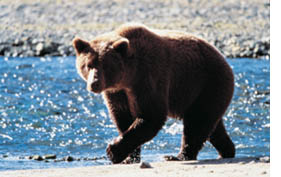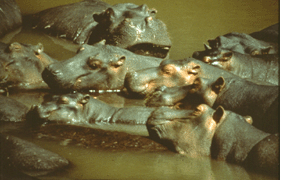
Conservation
Conservation is the protection, preservation, management, or restoration
of wildlife and natural resources such as forests and water. Through
the conservation of biodiversity the survival of many species and
habitats which are threatened due to human activities can be ensured.
Other reasons for conserving biodiversity include securing valuable
Natural Resources for future generations and protecting the well
being of eco-system functions. Other services provided from biodiversity
by following this link:
Services for Biodiversity page
In-situ and ex-situ conservation
Conservation can broadly be divided into two types:
In-situ: Conservation of habitats, species and
ecosystems where they naturally occur. This is in-situ conservation
and the natural processes and interaction are conserved as well
as the elements of biodiversity.
Ex-situ: The conservation of elements of biodiversity
out of the context of their natural habitats is referred to as ex-situ
conservation. Zoos, botanical gardens and seed banks are all example
of ex-situ conservation.
In-situ conservation is not always possible as habitats may have
been degraded and there may be competition for land which means
species need to be removed from the area to save them.
Which areas to conserve?
Hotspots of biodiversity
A popular approach for selecting priority areas has been to select
hotspots of diversity. Since it is not possible to conserve all
biodiversity due to lack of resources and the need to use land for
human activities, areas are prioritised to those which are most
in need of conservation. ‘Hotspot’ a term used to define
regions of high conservation priority combining high richness, high
endemism and high threat. For more information on hotspots visit:
www.biodiversityhotspots.org
Threatened Species
Over the last 200 years many species have become extinct and the
extinction rate is on the increase due to the influence of human
activity. The status of species has been assessed on a global scale
by the World Conservation Union. Taxa that are facing a high risk
of global extinction are catalogued and highlighted in the IUCN
Red List of Threatened Species. The Red list database and guidelines
on the application of IUCN Red List criteria at sub-national or
regional levels can be accessed by following the links below:
Red list database: www.redlist.org
Guidelines for use: www.iucn.org/themes/ssc/redlists/regionalguidelines.htm

Threatened Habitats
Habitat destruction comes in many forms from clear felling of forests
to simple changes in farming practices that change the overall surrounding
habitat. If a habitat is degraded or disappears a species may also
become threatened. The UK is in danger of losing diverse habitats
ranging from lowland calcareous grassland to mudflats and wet woodland.
The UK
BAP has specific Habitat Action Plans in place in order to try
and mange and conserve these precious places. Many of these areas
lie within SSSIs which are designated prioritised areas of conservation.
Flagship and keystone species
Conservation efforts are often focused on a single species. This
is usually for two reasons.
1) Some species are key to the functioning of a habitat and their
loss would lead to greater than average change in other species
populations or ecosystem processes. These are known as keystone
species.
2) Humans will find the idea of conserving one species more appealing
than conserving others. For example it would be easier to persuade
people that it is necessary to conserve tigers that it is to persuade
people to conserve the Zayante band-winged grasshopper. Using a
flagship species such as a tiger will attract more resources for
conservation which can be used to conserve areas of habitat.
Complementarity
Complementarity is a method used to select areas for conservation.
These methods are used to find areas that in sum total have the
highest representation of diversity. For example using complementarity
methods, areas could be selected that would contain the most species
between them but not necessarily be the most species rich areas
individually and take into account pressures of development.
Distinguishing higher from lower priority areas for urgent conservation
is the purpose of such area-selection methods. However, an acceptance
of priorities must recognise that this idea also implies that some
areas will be given lower priority. This is not to say that they
have no conservation values rather that in relation to agreed goals
the actions are not as urgent.
Where identities of species or other biodiversity indicators (see
the measuring biodiversity page) are known, complementarity
methods can be applied
Integrating conservation and development
Conservation can not be conducted in isolation from humans and for
conservation to be successful and sustainable there needs to be
local community involvement. In the UK most biodiversity is found
in countryside which is farmed. It is therefore necessary to integrate
conservation into farming practices. In other areas of the world
livelihood and development priorities of local communities must
be taken into account if the conservation measures are to be sustainable.
Community-Based Natural Resource Management is a process through
which grass roots institutions are involved in the decision making
and have rights to manage and control their environment. CBNRM Net
(Community-Based
Natural Resource Management Network) is a website that provides
useful networking tools so that people can exchange experiences,
manage relevant knowledge, and support learning across countries
and cultures and in this way achieve better results. IIED have set
up a Biodiversity
and Livelihoods Group which aims through sustainable management
of biodiversity to improve the livelihoods of the poor. BLG researches,
analyses and implements new projects and strategies around the world.
 A
good example this type of integration is being shown by an Earthwatch
project in Africa. The project helped create a wildlife reserve
that was initiated by the Wechiau and Tokali local communities.
The Wechiau Community Hippo Sanctuary now generates income for the
local communities via eco-tourism which helps conserve and protect
hippos and other sanctuary wildlife at the same time. This expedition
and other Earthwatch expeditions can be found at: http://www.earthwatch.org/expedselect.html A
good example this type of integration is being shown by an Earthwatch
project in Africa. The project helped create a wildlife reserve
that was initiated by the Wechiau and Tokali local communities.
The Wechiau Community Hippo Sanctuary now generates income for the
local communities via eco-tourism which helps conserve and protect
hippos and other sanctuary wildlife at the same time. This expedition
and other Earthwatch expeditions can be found at: http://www.earthwatch.org/expedselect.html
The Main International and UK Designations for Conservation
In order to protect different areas across the world sites are
designated for conservation. Different designations of protection
are given to sites depending on what the site contains and it’s
priorities for conservation and management. The IUCN definition
of a protected area is as follows:
An area of land and/or sea especially dedicated to the protection
and maintenance of biological diversity, and of natural and associated
cultural resources, and managed through legal or other effective
means
IUCN Protected Area Management Categories
Category
|
Management Area |
Mainly managed for: |
1a
1b |
Strict Nature Reserve |
Wilderness Area Science
Wilderness protection |
| 2 |
National Park |
Ecosystem protection and recreation |
| 3 |
Natural Monument |
Conservation of specific natural features |
| 4 |
Habitat/species |
Conservation through management intervention |
| 5 |
Protected Landscape/Seascape |
Landscape/seascape conservation and recreation |
| 6 |
Managed Resource Protected Area |
Sustainable use of natural ecosystems |
UK designation
| Sites of Special Scientific Interest (SSSI’s)
– designated under National Parks and Access to the Countryside
Act (NP&AC), Wildlife and Countryside Act (WCA) and CRoW
Act. |
| Areas of Special Scientific Interest (ASSI’s)
(Northern Ireland) – Environment (NI) Order |
| Nature Conservation Order – WCA |
| Special Nature Conservation Order –
habitats regulations |
| Marine nature reserves – WCA |
| Areas of Special Protection for Birds –
WCA |
| Bird Sanctuaries – Protection of Birds
Act |
| National Parks – NP&AC |
| Areas of Outstanding Natural Beauty (AONB)
– NP&AC |
| National Scenic Areas (Scotland) –
NP&AC |
| Environmentally sensitive Areas - Agriculture
Act |
| Natural Heritage Areas – Natural heritage
(Scotland) Act |
| Limestone Pavement Orders – WCA |
| Nature Conservation review sites –
Listed in the Nature Conservation review |
| Geological conservation review (GCR) sites |
| Local Nature reserves – NP&AC |
International
| Ramsar sites – designated under the
Convention on Wetlands of international Importance. |
| Biosphere reserves – designated under
the UNESCO Man and The biosphere Programme |
| Biogenetic reserves – designated under
the Berne Convention |
| World Heritage sites – designated under
the UNESCO Convention for the Protection of World Cultural and
Natural Heritage. |
| European sites and candidate European sites
– Includes Special Areas of Conservation (SAC’s)
- designated under the Habitats Directive. Special Protected
Areas (SPA’s) designated under the Wild Birds Directive. |
| European Diploma sites – designated
by Council of Europe |
.
Photo credit: Grizzly bear, Bruce Belcher.
Hippos and woman doing conservation work, Laura Morrison.
|




